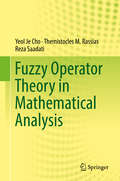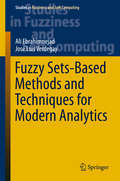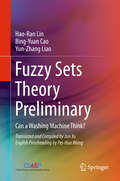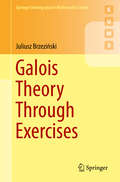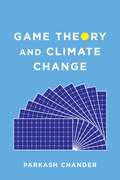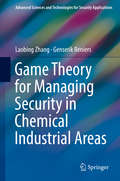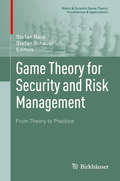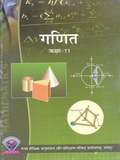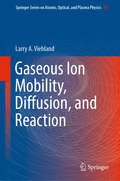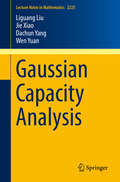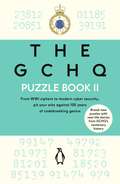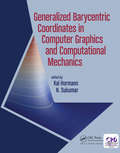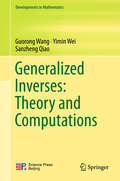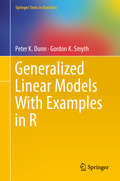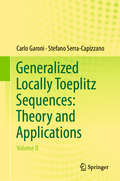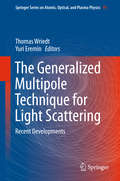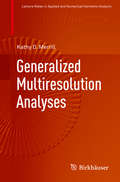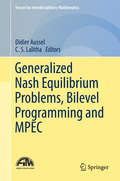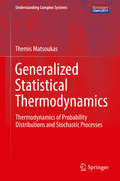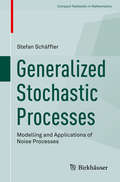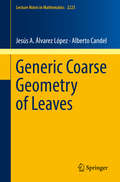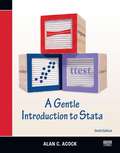- Table View
- List View
Fuzzy Operator Theory in Mathematical Analysis
by Yeol Je Cho Themistocles M. Rassias Reza SaadatiThis self-contained monograph presents an overview of fuzzy operator theory in mathematical analysis. Concepts, principles, methods, techniques, and applications of fuzzy operator theory are unified in this book to provide an introduction to graduate students and researchers in mathematics, applied sciences, physics, engineering, optimization, and operations research. New approaches to fuzzy operator theory and fixed point theory with applications to fuzzy metric spaces, fuzzy normed spaces, partially ordered fuzzy metric spaces, fuzzy normed algebras, and non-Archimedean fuzzy metric spaces are presented. Surveys are provided on: Basic theory of fuzzy metric and normed spaces and its topology, fuzzy normed and Banach spaces, linear operators, fundamental theorems (open mapping and closed graph), applications of contractions and fixed point theory, approximation theory and best proximity theory, fuzzy metric type space, topology and applications.
Fuzzy Sets-Based Methods and Techniques for Modern Analytics (Studies in Fuzziness and Soft Computing #364)
by José Luis Verdegay Ali EbrahimnejadThe book offers a comprehensive, practice-oriented introduction to the field of fuzzy mathematical programming (FMP) as key topic of modern analytics. FMP plays a fundamental role in dealing with a varied range of problems, such as those concerning smart cities, sustainability, and renewable energies. This book includes an introduction to the basic concepts, together with extensive information on the computational-intelligence-based optimization models and techniques that have been used to date. Special emphasis is given to fuzzy transportation problems. The book is a valuable resource for researchers, data scientists and practitioners dealing with computational-intelligence-based optimization models for analytics.
Fuzzy Sets Theory Preliminary: Can A Washing Machine Think?
by Bing-Yuan Cao Hao-Ran Lin Yun-Zhang LiaoThis basic book has been used at the middle schools in Shanghai, China for more than 10 years. The book presents carefully-selected contents in order to achieve the roles of enlightenment and popularization. It mainly includes: Chapter 1: Human Brains, Computers and Fuzzy Mathematics; Chapter 2: Matrix, Fuzzy Relations and Fuzzy Matrix; Chapter 3: Fuzzy Control; Chapter 4: Fuzzy Statistics and Fuzzy Probability and Chapter 5: Fuzzy Linear Programming. It includes at the end of each chapter concise, interesting and profound reading and thinking materials, and a certain amount of exercises so as to make it an informative and interesting textbook. This book can be used not only as a textbook in senior middle schools, and in vocational colleges, but also as a primer for individually learning fuzzy mathematics.
Galois Theory Through Exercises (Springer Undergraduate Mathematics Series)
by Juliusz BrzezińskiProvides a hands-on approach to learning Galois theory, focusing on problem-solving exercises.<P><P> Features almost 500 exercises with hints, answers or solutions.<P> Includes Maple tutorials and exercises.<P> This textbook offers a unique introduction to classical Galois theory through many concrete examples and exercises of varying difficulty (including computer-assisted exercises).<P> In addition to covering standard material, the book explores topics related to classical problems such as Galois’ theorem on solvable groups of polynomial equations of prime degrees, Nagell's proof of non-solvability by radicals of quintic equations, Tschirnhausen's transformations, lunes of Hippocrates, and Galois' resolvents. Topics related to open conjectures are also discussed, including exercises related to the inverse Galois problem and cyclotomic fields. The author presents proofs of theorems, historical comments and useful references alongside the exercises, providing readers with a well-rounded introduction to the subject and a gateway to further reading.<P> A valuable reference and a rich source of exercises with sample solutions, this book will be useful to both students and lecturers. Its original concept makes it particularly suitable for self-study.
Game Theory and Climate Change
by Parkash ChanderDespite the growing consensus on the need for action to counteract climate change, complex economic and political forces have so far prevented international actors from making much headway toward resolving the problem. Most approaches to climate change are based in economics and environmental science; in this book, Parkash Chander argues that we can make further progress on the climate change impasse by considering a third approach—game theory.Chander shows that a game-theoretic approach, which offers insight into the nature of interactions between sovereign countries behaving strategically and the kinds of outcomes such interactions produce, can illuminate how best to achieve international agreements in support of climate-change mitigation strategies. Game Theory and Climate Change develops a conceptual framework with which to analyze climate change as a strategic or dynamic game, bringing together cooperative and noncooperative game theory and providing practical analyses of international negotiations. Chander offers economic and game-theoretic interpretations of both the Kyoto Protocol and the Paris Agreement and argues that the Paris Agreement may succeed where the Kyoto Protocol failed. Finally, Chander discusses the policy recommendations his framework generates, including a global agreement to support development of cleaner technologies on a global scale.
Game Theory for Managing Security in Chemical Industrial Areas (Advanced Sciences and Technologies for Security Applications)
by Laobing Zhang Genserik ReniersThis book systematically studies how game theory can be used to improve security in chemical industrial areas, capturing the intelligent interactions between security managers and potential adversaries. The recent unfortunate terrorist attacks on critical infrastructures show that adversaries are intelligent and strategic. Game theoretic models have been extensively used in some domains to model these strategic adversaries. However, there is a lack of such advanced models to be employed by chemical security managers. In this book, game theoretic models for protecting chemical plants as well as clusters are proposed. Different equilibrium concepts are explored, with user-friendly explanation of how to reflect them to realistic cases. Based on efficient analysis of the properties of security issues in chemical plants/clusters, models in this book are capable to support resources allocations, cost-effectiveness analysis, cooperation incentives and alike.
Game Theory for Security and Risk Management: From Theory to Practice (Static & Dynamic Game Theory: Foundations & Applications)
by Stefan Schauer Stefan RassThe chapters in this volume explore how various methods from game theory can be utilized to optimize security and risk-management strategies. Emphasizing the importance of connecting theory and practice, they detail the steps involved in selecting, adapting, and analyzing game-theoretic models in security engineering and provide case studies of successful implementations in different application domains. Practitioners who are not experts in game theory and are uncertain about incorporating it into their work will benefit from this resource, as well as researchers in applied mathematics and computer science interested in current developments and future directions.The first part of the book presents the theoretical basics, covering various different game-theoretic models related to and suitable for security engineering. The second part then shows how these models are adopted, implemented, and analyzed. Surveillance systems, interconnected networks, and power grids are among the different application areas discussed. Finally, in the third part, case studies from business and industry of successful applications of game-theoretic models are presented, and the range of applications discussed is expanded to include such areas as cloud computing, Internet of Things, and water utility networks.
Ganit class 11 - S.C.E.R.T Raipur - Chhattisgarh Board: गणित कक्षा 11 - एस.सी.ई.आर.टी. रायपुर छत्तीसगढ़ बोर्ड
by Rajya Shaikshik Anusandhan Aur Prashikshan Parishad Chhattisgarh Raipur C.G.गणित कक्षा 11 वीं का राज्य शैक्षिक अनुसंधान और प्रशिक्षण परिषद् छत्तीसगढ़ रायपुर ने पुस्तक हिंदी भाषा में प्रकाशित किया गया है, इस पाठपुस्तक में पंधरह अध्याय दिये गये है, जिसमे हर अध्याय के विवरण कि व्याख्या कि गई है ।
Ganit class 4 - GSTB: ગણિત ધોરણ ૪ - જીએસટીબી
by Kinnariben Dave Dr Bharat J. Pathakપ્રસ્તુત પાઠ્યપુસ્તક ધોરણ ૪ ના ગણિત વિષયનું છે.
Ganit class 8 - GSTB: ગણિત ધોરણ ૮ - જીએસટીબી
by Gstbઆ પાઠ્ય પુસ્તકનો અનુવાદ તથા તેની સમીક્ષા નિષ્ણાત પ્રાધ્યાપકો અને શિક્ષકો પાસે કરાવવામાં આવ્યા છે અને સમીક્ષકોનાં સૂચનો અનુસાર હરતપ્રતમાં યોગ્ય સુધારા - વધારા કર્યા પછી આ પાઠયપુસ્તક પ્રસિદ્ધ કરવામાં આવેલ છે. જેમાં ૧૬ પ્રકરણ અને સ્વાધ્યાય આપેલ છે.
Gaseous Ion Mobility, Diffusion, and Reaction (Springer Series on Atomic, Optical, and Plasma Physics #105)
by Larry A. ViehlandThis book is about the drift, diffusion, and reaction of ions moving through gases under the influence of an external electric field, the gas temperature, and the number density. While this field was established late in the 19th century, experimental and theoretical studies of ion and electron swarms continue to be important in such varied fields as atomic and molecular physics, aeronomy and atmospheric chemistry, gaseous electronics, plasma processing, and laser physics. This book follows in the rigorous tradition of well-known older books on the subject, while at the same time providing a much-needed overview of modern developments with a focus on theory. Graduate students and researchers new to this field will find this book an indispensable guide, particularly those involved with ion mobility spectrometry and the use of ion transport coefficients to test and improve ab initio ion-neutral interaction potentials. Established researchers and academics will find in this book a modern companion to the classic references.
Gaussian Capacity Analysis (Lecture Notes in Mathematics #2225)
by Liguang Liu Jie Xiao Dachun Yang Wen YuanThis monograph develops the Gaussian functional capacity theory with applications to restricting the Gaussian Campanato/Sobolev/BV space. Included in the text is a new geometric characterization of the Gaussian 1-capacity and the Gaussian Poincaré 1-inequality. Applications to function spaces and geometric measures are also presented. This book will be of use to researchers who specialize in potential theory, elliptic differential equations, functional analysis, probability, and geometric measure theory.
The GCHQ Puzzle Book II
by GCHQTrain your brain with these fiendishly difficult puzzles, the perfect companion for anyone wanting to keep their mind busy'Fiendishly tricky' Daily MailWith their first bestselling book, The GCHQ Puzzle Book, the UK's intelligence and security experts tested us with puzzles, codes and real-life entrance tests from their archives.Now, they are back with a NEW collection of head-scratching, mind-boggling and brain-bending puzzles that will leave you pondering for hours.For those who often found themselves stumped with the first book, The GCHQ Puzzle Book 2 offers even more starter puzzles to get those brains warmed up. Puzzle aficionados needn't worry though, as there is also an 'Even Harder' section to test everyone to their limits . . .Not only that, but in celebration of GCHQ's centenary, the puzzles in this new book sit alongside stories, facts and photos from the organisation's first 100 years at the heart of the nation's security. From the Government Code & Cipher School, to Bletchley Park, through to protecting against cyberattacks, the security of our country is in the hands of GCHQ. With this book, you get exclusive snapshots into the organisation that keeps us all safe.Train your brain to compete with the smartest in the country with this stimulating book of puzzles. If you haven't yet tested yourself with the first instalment of The GCHQ Puzzle Book, check it out now!'This is the perfect gift to fuel his ludicrous presumption that he could have definitely been a spy - even better if he's already dog-eared the first version' Huffington Post
Generalized Barycentric Coordinates in Computer Graphics and Computational Mechanics
by Kai Hormann N. SukumarIn Generalized Barycentric Coordinates in Computer Graphics and Computational Mechanics, eminent computer graphics and computational mechanics researchers provide a state-of-the-art overview of generalized barycentric coordinates. Commonly used in cutting-edge applications such as mesh parametrization, image warping, mesh deformation, and finite as well as boundary element methods, the theory of barycentric coordinates is also fundamental for use in animation and in simulating the deformation of solid continua. Generalized Barycentric Coordinates is divided into three sections, with five chapters each, covering the theoretical background, as well as their use in computer graphics and computational mechanics. A vivid 16-page insert helps illustrating the stunning applications of this fascinating research area. <P><P>Key Features: <li>Provides an overview of the many different types of barycentric coordinates and their properties. <li>Discusses diverse applications of barycentric coordinates in computer graphics and computational mechanics. <li>The first book-length treatment on this topic
Generalized Inverses: Theory and Computations (Developments in Mathematics #53)
by Sanzheng Qiao Yimin Wei Guorong WangThis book begins with the fundamentals of the generalized inverses, then moves to more advanced topics.It presents a theoretical study of the generalization of Cramer's rule, determinant representations of the generalized inverses, reverse order law of the generalized inverses of a matrix product, structures of the generalized inverses of structured matrices, parallel computation of the generalized inverses, perturbation analysis of the generalized inverses, an algorithmic study of the computational methods for the full-rank factorization of a generalized inverse, generalized singular value decomposition, imbedding method, finite method, generalized inverses of polynomial matrices, and generalized inverses of linear operators. This book is intended for researchers, postdocs, and graduate students in the area of the generalized inverses with an undergraduate-level understanding of linear algebra.
Generalized Linear Models With Examples in R (Springer Texts in Statistics)
by Peter K. Dunn Gordon K. SmythThis textbook presents an introduction to multiple linear regression, providing real-world data sets and practice problems. A practical working knowledge of applied statistical practice is developed through the use of these data sets and numerous case studies. The authors include a set of practice problems both at the end of each chapter and at the end of the book. Each example in the text is cross-referenced with the relevant data set, so that readers can load the data and follow the analysis in their own R sessions. The balance between theory and practice is evident in the list of problems, which vary in difficulty and purpose.This book is designed with teaching and learning in mind, featuring chapter introductions and summaries, exercises, short answers, and simple, clear examples. Focusing on the connections between generalized linear models (GLMs) and linear regression, the book also references advanced topics and tools that have not typically been included in introductions to GLMs to date, such as Tweedie family distributions with power variance functions, saddlepoint approximations, likelihood score tests, modified profile likelihood, and randomized quantile residuals. In addition, the authors introduce the new R code package, GLMsData, created specifically for this book. Generalized Linear Models with Examples in R balances theory with practice, making it ideal for both introductory and graduate-level students who have a basic knowledge of matrix algebra, calculus, and statistics.
Generalized Locally Toeplitz Sequences: Volume I
by Carlo Garoni Stefano Serra-CapizzanoBased on the authors’ research experience, this two-volume reference textbook focuses on the theory of generalized locally Toeplitz sequences and its applications. The first volume discusses the univariate version of the theory and the related applications in the unidimensional setting, while this second volume, which addresses the multivariate case, is mainly devoted to concrete PDE applications. This book systematically develops the multivariate version of the theory of generalized locally Toeplitz (GLT) sequences and presents some of its main applications to the numerical discretization of partial differential equations (PDEs). Written for applied mathematicians, engineers, physicists, and scientists who (perhaps unknowingly) encounter GLT sequences in their research, it is also of interest to those working in the fields of Fourier and functional analysis, spectral analysis of PDE discretization matrices, matrix analysis, numerical analysis, linear and multilinear algebra. Further, it can be used as a textbook for graduate or advanced undergraduate courses in numerical analysis.
The Generalized Multipole Technique for Light Scattering: Recent Developments (Springer Series on Atomic, Optical, and Plasma Physics #99)
by Thomas Wriedt Yuri EreminThis book presents the Generalized Multipole Technique as a fast and powerful theoretical and computation tool to simulate light scattering by nonspherical particles. It also demonstrates the considerable potential of the method. In recent years, the concept has been applied in new fields, such as simulation of electron energy loss spectroscopy and has been used to extend other methods, like the null-field method, making it more widely applicable. The authors discuss particular implementations of the GMT methods, such as the Discrete Sources Method (DSM), Multiple Multipole Program (MMP), the Method of Auxiliary Sources (MAS), the Filamentary Current Method (FCM), the Method of Fictitious Sources (MFS) and the Null-Field Method with Discrete Sources (NFM-DS). The Generalized Multipole Technique is a surface-based method to find the solution of a boundary-value problem for a given differential equation by expanding the fields in terms of fundamental or other singular solutions of this equation. The amplitudes of these fundamental solutions are determined from the boundary condition at the particle surface. Electromagnetic and light scattering by particles or systems of particles has been the subject of intense research in various scientific and engineering fields, including astronomy, optics, meteorology, remote sensing, optical particle sizing and electromagnetics, which has led to the development of a large number of modelling methods based on the Generalized Multipole Technique for quantitative evaluation of electromagnetic scattering by particles of various shapes and compositions. The book describes these methods in detail.
Generalized Multiresolution Analyses (Applied and Numerical Harmonic Analysis)
by Kathy D. MerrillThis monograph presents the first unified exposition of generalized multiresolution analyses. Expanding on the author’s pioneering work in the field, these lecture notes provide the tools and framework for using GMRAs to extend results from classical wavelet analysis to a more general setting. Beginning with the basic properties of GMRAs, the book goes on to explore the multiplicity and dimension functions of GMRA, wavelet sets, and generalized filters. The author’s constructions of wavelet sets feature prominently, with figures to illustrate their remarkably simple geometric form. The last three chapters exhibit extensions of wavelet theory and GMRAs to other settings. These include fractal spaces, wavelets with composite dilations, and abstract constructions of GMRAs beyond the usual setting of L2(ℝn).This account of recent developments in wavelet theory will appeal to researchers and graduate students with an interest in multiscale analysis from a pure or applied perspective. Familiarity with harmonic analysis and operator theory will be helpful to the reader, though the only prerequisite is graduate level experience with real and functional analysis.
Generalized Nash Equilibrium Problems, Bilevel Programming and MPEC (Forum for Interdisciplinary Mathematics)
by C. S. Lalitha Didier AusselThe book discusses three classes of problems: the generalized Nash equilibrium problems, the bilevel problems and the mathematical programming with equilibrium constraints (MPEC). These problems interact through their mathematical analysis as well as their applications. The primary aim of the book is to present the modern tool of variational analysis and optimization, which are used to analyze these three classes of problems. All contributing authors are respected academicians, scientists and researchers from around the globe. These contributions are based on the lectures delivered by experts at CIMPA School, held at the University of Delhi, India, from 25 November–6 December 2013, and peer-reviewed by international experts. The book contains five chapters. Chapter 1 deals with nonsmooth, nonconvex bilevel optimization problems whose feasible set is described by using the graph of the solution set mapping of a parametric optimization problem. Chapter 2 describes a constraint qualification to MPECs considered as an application of calmness concept of multifunctions and is used to derive M-stationarity conditions for MPEC. Chapter 3 discusses the first- and second-order optimality conditions derived for a special case of a bilevel optimization problem in which the constraint set of the lower level problem is described as a general compact convex set. Chapter 4 concentrates the results of the modelization and analysis of deregulated electricity markets with a focus on auctions and mechanism design. Chapter 5 focuses on optimization approaches called reflection methods for protein conformation determination within the framework of matrix completion. The last chapter (Chap. 6) deals with the single-valuedness of quasimonotone maps by using the concept of single-directionality with a special focus on the case of the normal operator of lower semi-continuous quasiconvex functions.
Generalized Statistical Thermodynamics: Thermodynamics of Probability Distributions and Stochastic Processes (Understanding Complex Systems)
by Themis MatsoukasThis book gives the definitive mathematical answer to what thermodynamics really is: a variational calculus applied to probability distributions. Extending Gibbs's notion of ensemble, the Author imagines the ensemble of all possible probability distributions and assigns probabilities to them by selection rules that are fairly general. The calculus of the most probable distribution in the ensemble produces the entire network of mathematical relationships we recognize as thermodynamics. The first part of the book develops the theory for discrete and continuous distributions while the second part applies this thermodynamic calculus to problems in population balance theory and shows how the emergence of a giant component in aggregation, and the shattering transition in fragmentation may be treated as formal phase transitions. While the book is intended as a research monograph, the material is self-contained and the style sufficiently tutorial to be accessible for self-paced study by an advanced graduate student in such fields as physics, chemistry, and engineering.
Generalized Stochastic Processes: Modelling and Applications of Noise Processes (Compact Textbooks in Mathematics)
by Stefan SchäfflerThis textbook shall serve a double purpose: first of all, it is a book about generalized stochastic processes, a very important but highly neglected part of probability theory which plays an outstanding role in noise modelling. Secondly, this textbook is a guide to noise modelling for mathematicians and engineers to foster the interdisciplinary discussion between mathematicians (to provide effective noise models) and engineers (to be familiar with the mathematical backround of noise modelling in order to handle noise models in an optimal way).Two appendices on "A Short Course in Probability Theory" and "Spectral Theory of Stochastic Processes" plus a well-choosen set of problems and solutions round this compact textbook off.
Generic Coarse Geometry of Leaves (Lecture Notes in Mathematics #2223)
by Jesús A. Álvarez López Alberto CandelThis book provides a detailed introduction to the coarse quasi-isometry of leaves of a foliated space and describes the cases where the generic leaves have the same quasi-isometric invariants. Every leaf of a compact foliated space has an induced coarse quasi-isometry type, represented by the coarse metric defined by the length of plaque chains given by any finite foliated atlas. When there are dense leaves either all dense leaves without holonomy are uniformly coarsely quasi-isometric to each other, or else every leaf is coarsely quasi-isometric to just meagerly many other leaves. Moreover, if all leaves are dense, the first alternative is characterized by a condition on the leaves called coarse quasi-symmetry. Similar results are proved for more specific coarse invariants, like growth type, asymptotic dimension, and amenability. The Higson corona of the leaves is also studied. All the results are richly illustrated with examples. The book is primarily aimed at researchers on foliated spaces. More generally, specialists in geometric analysis, topological dynamics, or metric geometry may also benefit from it.
A Gentle Course in Local Class Field Theory: Local Number Fields, Brauer Groups, Galois Cohomology
by Pierre GuillotThis book offers a self-contained exposition of local class field theory, serving as a second course on Galois theory. It opens with a discussion of several fundamental topics in algebra, such as profinite groups, p-adic fields, semisimple algebras and their modules, and homological algebra with the example of group cohomology. The book culminates with the description of the abelian extensions of local number fields, as well as the celebrated Kronecker–Weber theory, in both the local and global cases. The material will find use across disciplines, including number theory, representation theory, algebraic geometry, and algebraic topology. Written for beginning graduate students and advanced undergraduates, this book can be used in the classroom or for independent study.
A Gentle Introduction To Stata
by Alan C. AcockAcock assumes that the user is not familiar with any statistical software. This assumption of a blank slate is central to the structure and contents of the book. Acock starts with the basics; for example, the part of the book that deals with data management begins with a careful and detailed example of turning survey data on paper into a Stata-ready dataset on the computer. When explaining how to go about basic exploratory statistical procedures, Acock includes notes that will help the reader develop good work habits. This mixture of explaining good Stata habits and good statistical habits continues throughout the book.
